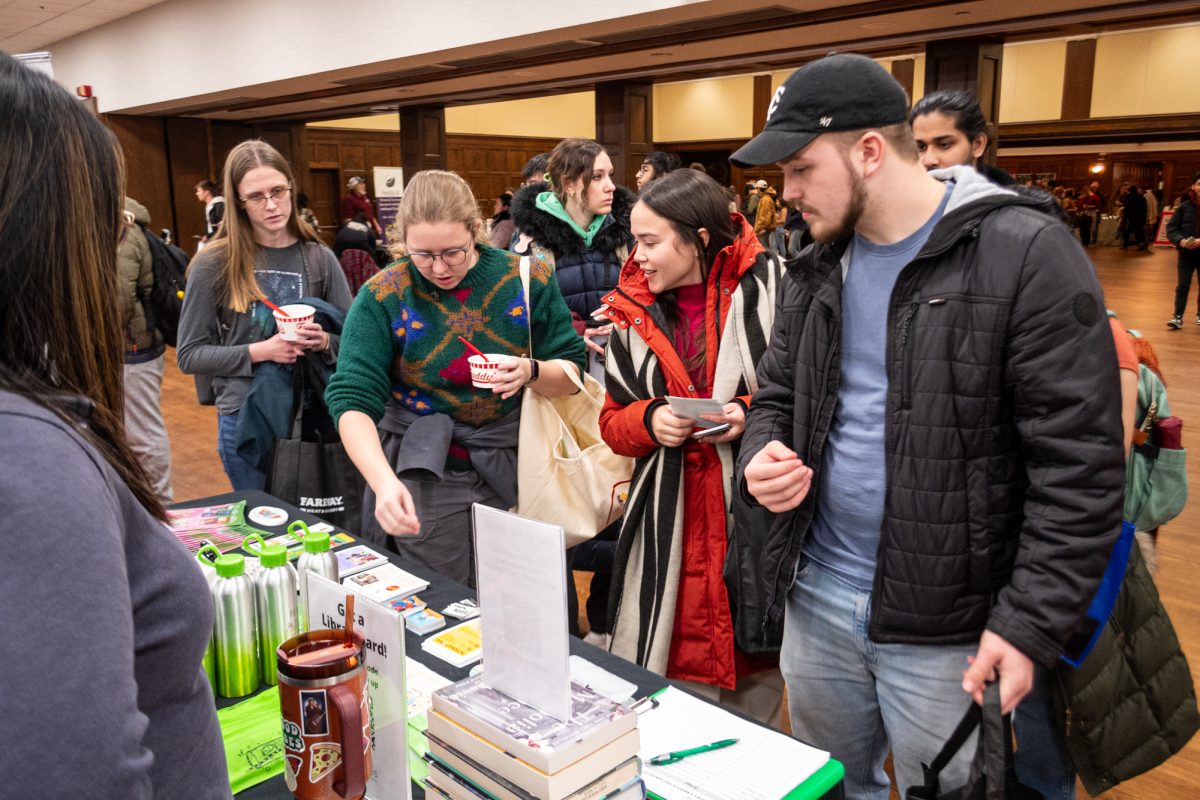The Daily Grind
October 9, 2002
Driving down 6th Street, it’s hard to miss the 10,500-square-foot slab of concrete across from Brookside Park. Cars drive a little slower past this area. Passers-by pause at this site to take a peek.
Adults line the red fence, holding cameras and video cameras, and talking with each other about their kids and the tricks they’ve pulled or the falls they’ve taken. From dawn until dusk, skateboarders and in-line skaters are seen at Ames’ own skate park, one of only a handful in the state.
It’s been that way for about a month, and over the weekend the park was made official with a ribbon-cutting ceremony.
“It’s exciting to have a place for youth to enjoy in-lining and skateboarding,” Ames Mayor Ted Tedesco said Saturday at the ribbon-cutting ceremony. “I’m surprised how well they all get along together.”
This $200,000 construction project has been a work in progress since 1998, says Nancy Carroll, director of Ames Parks and Recreation. In 1998, the state Legislature waived liability for in-line skaters and skateboarders if they would build a skate park — the reason the park only accommodates those two sports.
The evolution of the park was a combined effort between the Ames City Council, Ames Parks and Recreation, Iowa State and other Ames organizations.
“We felt like there was an actual need and the usage would warrant it for skateboarders and in-liners,” Carroll says. “We wanted to give them a place so they wouldn’t be using Durham, Parks Library or the Ames Library.”
In fact, pieces of the skate park were chosen specifically to emulate popular stomping grounds on campus and around Ames that skateboarders and in-liners frequent.
“I believe we have not received as many complaints about skateboarding in areas such as downtown where we would receive a number of complaints in the past,” says Cmdr. Jim Robinson of the Ames Police Department.
“I believe the skate park is helping out.”
Warren Madden, vice president for Business and Finance, hopes the addition of the skate park will lessen traffic on campus as well.
“I’m hoping there will be a little less of it on the library steps, and more of it [at the skate park],” Madden said at the ribbon-cutting ceremony.
“There is an ulterior motive.”
One campus organization, Skateboarding Anonymous, is glad to see the addition of the park to Ames. The club, which president Andrew Pratt says he can be contacted at [email protected], is designed for ISU skateboarders to meet and skate with each other. Pratt says he skates on campus, but not as frequently since the park opened.
“It’s actually a good park,” says Pratt, sophomore in liberal arts and sciences. “I’ll go over there in a second before I’ll go over to the library. I’d say it’s the best park in Iowa right now for sure.”
However, should he ever tire of the skate park, Pratt might skate his way back onto campus.
“You’re always up for a change of scenery,” he says.
One drawback of skating on campus is ISU Police interference. Pratt says he’s had quite a few run-ins with officers while skateboarding on campus.
“I’ve got to watch out for police and [ISU Police] because they told me they’d charge me with various things if I got caught skateboarding again,” Pratt says.
Most prohibitions include skating on an elevated surface, such as a railing, says Capt. Gene Deisinger of ISU Police.
“Usually the initial contacts involve a warning to leave the area,” Deisinger says. “If they’ve been warned and refused, it can be simple trespass, assuming they haven’t caused any damage.”
A simple misdemeanor can result in a fine ranging from $50 to $500 or 30 days in jail, pending sentencing by a judge. If property damage is involved, skaters could be ordered to pay compensation.
But Pratt doesn’t seem to mind his newfound skate home. Having already been to the park too many times to count, he says he’s met a lot of ISU students there who share his interest.
“A lot of times it’s kind of hard to meet other people who skateboard when you’re at a place like Iowa State where it’s not that popular,” Pratt says. “You start finding out there’s a lot more people around who skate that you didn’t know about.”
Located in a high-traffic area of Ames, the park has drawn many spectators — from parents to kids to curious passers-by.
“I think the skaters like that people come and watch them,” Carroll says. “It really is intriguing as a spectator.”
Pratt agrees that it’s kind of cool that spectators have taken such an interest in the sport, but really doesn’t care much about their presence either way.
“Once you start getting into skateboarding, you’re not doing it for someone else,” Pratt says. “They don’t really have an in-depth understanding of what you’re doing.”
For the skaters, the real challenges come from the other boarders, not from the spectators. Competition is fierce as skaters attempt to outdo each other.
“You can push each other to do new stuff and be creative,” Pratt says. “I wouldn’t say the spectators really fuel me as much as the other skaters.”
With parking only available across the street at Brookside Park, there is some concern for the safety of pedestrians crossing the street to the skate park while the people driving by might be watching the skaters more than the road.
“We haven’t had any problems as of yet,” Robinson says. “It can be a dangerous situation and hopefully people will be on the lookout both as pedestrians and motorists in the area.”
Traffic and pedestrians aren’t the only safety concerns that come with a skate park. Duffie Lorr, of the Iowa Brain Injury Association, was passing out fliers about concussions and selling helmets at the ribbon-cutting ceremony.
“I have seen kids taking falls that, yes, would produce a concussion,” said Lorr, of Ames, during the event. “The problem is persuading the skateboarders because apparently the big heroes don’t wear helmets.”
The skate park rules don’t require a helmet, but Lorr is hoping to persuade the skaters to take the precaution against concussions by selling them for $7 to $10.
Pratt has a different concern: The safety of inexperienced skateboarders who are skating next to more experienced boarders on the unforgiving cement.
“You get parents around town that bring their kids up and give their kids a skateboard and say ‘Hey, go play,'” Pratt says. “They think it’s a playground. It’s fast and it’s dangerous. Kids need to learn the basics before they come to the park.”
However, Robinson says the biggest problem for Ames Police so far has been bicyclists — who aren’t covered under the skate park’s liability laws — using the park. Since it wasn’t built to accommodate bicycles, they can also damage the concrete finish and metal coping.
So now that Ames has a skate park, and its popularity is rising, are there any plans for expansion?
“You just never know how things will evolve,” Carroll says. “Right now there [aren’t], but we’ll just see what interest and funding allow.”






